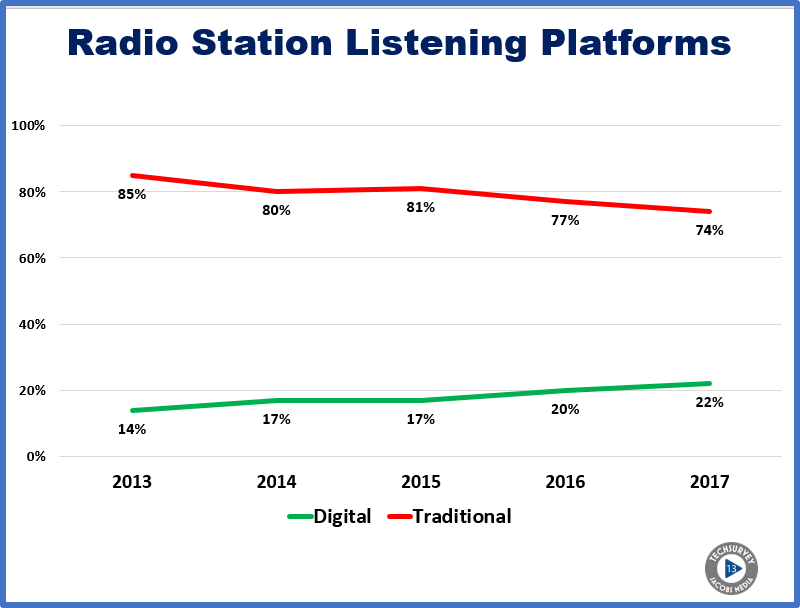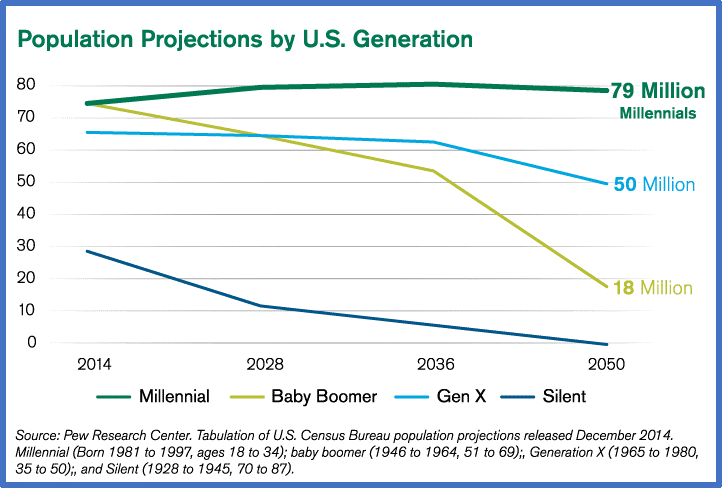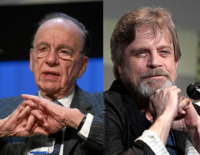 Many of you have already seen the new Star Wars movie – “The Last Jedi.” Over the weekend, the box office totaled a hefty $220 million, making it the second highest grossing movie of all time when released. (The winner? 2015’s “The Force Awakens” at $248 million.) I won’t spoil the movie for you, but every time I see one of these films (or the Star Trek series), I can’t help but think about the “mother ship” and its value to the entire enterprise (no pun intended).
Many of you have already seen the new Star Wars movie – “The Last Jedi.” Over the weekend, the box office totaled a hefty $220 million, making it the second highest grossing movie of all time when released. (The winner? 2015’s “The Force Awakens” at $248 million.) I won’t spoil the movie for you, but every time I see one of these films (or the Star Trek series), I can’t help but think about the “mother ship” and its value to the entire enterprise (no pun intended).
And that’s when radio’s odd predicament comes to mind.
Because without your “mother ship” – your AM or FM franchise – you’ve got nothing. Upwards of 70% of consumption of commercial and public stations still occurs on actual radios – the ones on nightstands, work benches, and embedded in dashboards.
And while digital consumption grows every year, listening on broadcast radios continues to make up the lion’s share of overall usage. This chart detailing “traditional” vs. digital consumption from the past five years clearly depicts the trajectory of where the radio industry is headed. It’s an inescapable truth, and something all broadcasters should be mindful of, as well as planning for.
 Your content and your User Experience on streams, podcasts, videos, social media, mobile phones, and now smart speakers is becoming more essential with each passing month. This is especially the case among Millennials, another reality that broadcasters must face up to. Whether you’re targeting Gen Y now or still thinking Boomers and Xers will be radio’s ultimate salvation, think again. Every brand – Home Depot, Walmart, Starbucks, and that nail salon down the street – has to plan and strategize for the audience shift younger. Same thing for WNYC, KROQ, and “The Bob & Tom Show” – they’d all better have a Millennial strategy in place.
Your content and your User Experience on streams, podcasts, videos, social media, mobile phones, and now smart speakers is becoming more essential with each passing month. This is especially the case among Millennials, another reality that broadcasters must face up to. Whether you’re targeting Gen Y now or still thinking Boomers and Xers will be radio’s ultimate salvation, think again. Every brand – Home Depot, Walmart, Starbucks, and that nail salon down the street – has to plan and strategize for the audience shift younger. Same thing for WNYC, KROQ, and “The Bob & Tom Show” – they’d all better have a Millennial strategy in place.
I am in the process of finalizing the questionnaire for Techsurvey 2018 with our Research Director, Jason Hollins. Of course, we’ll be tracking this very important question, while crafting others that go directly at this conundrum brands are facing as their demographic targets fissure.
The shift is not a surprising one, although if you pardon my inner nerd, I was struck by a quote from Luke Skywalker (Mark Hamill) in the new film:
“This is not going to go the way you think.”
Perhaps, but media CMOs and CEOs should have seen this coming. Today, many brands – and many radio stations are among them – are uncomfortably dealing with what is shaping up to be a bifurcated strategy: hanging onto the “old guard,” while figuring out to deal with a culture rapidly being dominated by youth and changing sensibilities.
You have my permission to bring this chart into your next marketing, research, strategy, or brainstorming meeting (but don’t blame me if it aggravates some people in the room).
 Some brands are grappling with this demographic dichotomy. As you’ve no doubt read in this blog this year, our “Millennial Project” commissioned by PRPD, catalyzed and hopefully inspired the public radio community. There are many conversations taking place in that world right now about the role of Millennials, and how programs, brands, and fundraising can be adapted to better accommodate their tastes, needs, and sensibilities – without upsetting the core, the “mother ship.”
Some brands are grappling with this demographic dichotomy. As you’ve no doubt read in this blog this year, our “Millennial Project” commissioned by PRPD, catalyzed and hopefully inspired the public radio community. There are many conversations taking place in that world right now about the role of Millennials, and how programs, brands, and fundraising can be adapted to better accommodate their tastes, needs, and sensibilities – without upsetting the core, the “mother ship.”
That came to mind recently when I read a story in AdWeek written by Chris Ariens about how the venerable “This Old House” is rethinking its content, branding, and marketing strategies. To address the Millennial challenge and opportunity, they’ve created “House One,” a new DIY platform that focuses on young people.
Interestingly, the decision to launch this initiative came right out of research. It turned out that 40% of the audience of “This Old House” was already in the Millennial generation. As CEO Eric Thorkilsen told AdWeek, “Wow, if they’re coming to ‘This Old House,” what if we created content customized to them?”
What if?
So, they’re on their way to creating a digital-only brand starting with social media and then launching a website as well as mobile, a key ingredient in the content mix. They’ve also gone out and found the perfect editor and leader of “House One.”
Jennifer Largesse is both a Millennial and a successful blogger, but also the daughter of a woodworker and teacher. She’ll be leveraging the venerable “This Old House” brand, while building a new portal geared toward an entirely new generation of homeowners.

Broadcasters have this same ability in the case of many, many brands. But it will require some of the same building blocks “This Old House” is utilizing: research, focus, and the right people in place to put it together. In the case of “This Old House” as well as every radio brand of value, the project is about protecting the “mother ship: – while building a key extension that ensures the franchise both survives and thrives. It’s about building that runway to the future.
Radio’s programmers are imbued with the responsibility of growing and maintaining the main brand. But who’s going to own an initiative like “House One” inside radio companies?
I think back to my days as a rock radio programmer, and it feels much the same way the cable news channels have been talking about “Watergate.” It happened – a long time ago. And while it has reverberations of what’s going on in the nation’s capitol today, it was a very different era in time.
When I was a PD, my main – and only responsibility – was the “mother ship.” I was responsible for what came out of those two speakers. And while there was some brand extension back then – events, merch, and lots of marketing – my mission was all about the FM property – keeping it healthy, vibrant, and thriving.
Today’s programmers are tasked with duties and responsibilities revolving around content creation and management most have not been trained to do. Whether it’s keeping an eye on the website, the app, the dashboard, Alexa, podcasts, the stream, social media pages (often several of them), and videos, many are running out of the bandwidth necessary to produce products that are competitive. And it will take truly great content and slick distribution outlets to grow the radio business.
There is a lot to be said for rethinking the structural integrity of broadcast companies and clusters. To accomplish this, many media brands have created positions like Chief Content Officers – “captains of content” that oversee the broad content and delivery mechanisms necessary to stay competitive – and grow. In that way, programmers, digital managers, and sales marketers all work together to advance the mission, reporting to a visionary who is paid to see out into hyperspace – and beyond.

In a world that’s consolidating down to Amazon, Google, Apple, Facebook, Netflix, and perhaps a handful of others, even Rupert Murdoch is envisioning an uncertain future. Last week, he let go of his prized 21st Century Fox – his TV, movie, and entertainment properties – by selling them off to Disney, another brand that isn’t content to run in place. As hard as it is to imagine, Murdoch’s vast holdings aren’t big and diverse enough to successfully compete against the aforementioned behemoths.
“Flat” is not the new up. And anyone who tells you that is making excuses. I would submit to you it’s the new “down.” Because if you’re flat, you’re not growing, changing, and adapting to the world around you. “Flat” is stagnant at a time when the world is turbo-charged with new gadgetry and innovation.
Perhaps Yoda was a consultant to the aforementioned studio (yes, they produce the “Star War” series now) as well as Lucasfilms. Maintaining the integrity of a great franchise but building a new, up and coming audience is media’s challenge. It’s not going to happen by mailing in yet another episode in the saga without an eye on a younger audience. That would not have made for a happy holiday season in a legacy entertainment industry struggling to draw crowds to theaters.
Protect the “mother ship” but grow the brand. It’s an engineering task that even Mr. Scott might struggle with, but the great ones overcome those odds.
The beauty of sci-fi movies is how they depict a future that is equal parts uncertain, challenging, and exciting. They take us to places we’ve not been before. And they force us to question the way things are going to work out – which is often not the way we think they will.
To compete in the years ahead as the demographic and cultural sands shift underneath us, radio is going to have to seek out new worlds and go where no broadcasters have gone before.
It’s a script that has yet to be written. But it’s a story any of us can star in.
Pass the popcorn and enjoy the show.
It’s not too late to sign up for Techsurvey 2018. Info and registration is here.
- What To Do If Your Radio Station Goes Through A Midlife Crisis - April 25, 2025
- A 2020 Lesson?It Could All Be Gone In A Flash - April 24, 2025
- How AI Can Give Radio Personalities More…PERSONALITY - April 23, 2025




Outstanding summation, Fred. Respecting The Millennial Future, it appears Boomers can handily pay for our working research, Mother Ship Protection and new extentions through at least 2028. “May the Force be with you.”
Most certainly, Clark. Live long & prosper.
Perhaps this is a good time to remind everyone that no one has ever made a dime playing music on a digital platform. The sad truth is that if music is involved, the mothership is profitable and digital platforms arent.
Sadly, the more radio gives people what they want, the more money it will cost the industry. Perhaps it’s time for radio to consider how expensive the current digital royalty system is for them and make a dramatic revision a priority.
Bob, you are correct, of course, that streaming is a loss leader (for now), but as habits gravitate online, radio is either there or loses out. I’ve done too many focus groups and one-on-ones in the past two years among respondents who don’t have a radio at home or in the workplace. For them, it’s entertainment on their mobile phones. Hopefully, radio has presence on these devices – even if it’s the stream.
I have to disagree here. Streaming is not a loss leader, its almost the opposite: “A loss leader (also leader) is a pricing strategy where a product is sold at a price below its market cost to stimulate other sales of more profitable goods or services.” (Wikipedia).
In radio’s case, “selling” streaming at a loss stimulates users to go FROM the profitable service to the one that TO one that always loses money. And suggesting that streaming is a money loser “for now” implies that there is some strategy at work to change the royalty structure and to my knowledge there isn’t anything like that being pursued.
I pay for and listen to a lot of music on a lot of different platforms and no one makes any real money on me. The streamers lose no matter what I do and the artists make a pittance – short of mailing a check “just because” there is no way for a streamer to make a profit on me and for artists, if I don’t go to their shows and/or buy their merchandise, they lose on me too. And radio, whose revenue stream is already down by 1/3 from its peak, has an audience clamoring for more streaming options. Offer them and add radio to that list of permanent money losers. The sad thing is that if radio’s programming talent was applied to those streaming platforms, they would probably be a lot better and liked even more. But I don’t blame radio for not paying for a path to a financial black hole.
o
This isn’t going away, isn’t going to get better and radio’s mothership has seen its best days. Is anyone willing to take this on, or are we just waiting until Apple and Google become Comcast and Charter for music?
Hey Bob, there is something being pursued.
You are on track, Bob. I must correct my statement, I meant that things are being pursued about network and streaming costs which have a significant impact too,